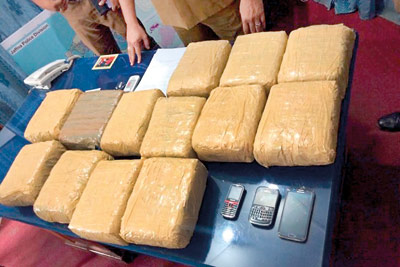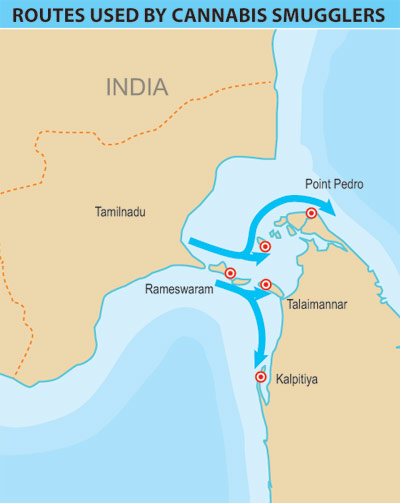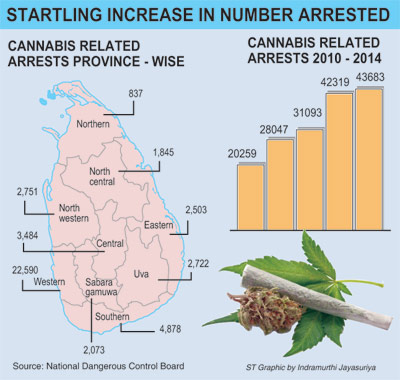News
Kerala ganja via the north freely available in Kalpitiya, Puttalam despite detections

A recent detection of ganja from Kerala
While the Jaffna Peninsula has become a ‘hub’ for the distribution of ‘Kerala Ganja (KG),’ authorities note that smugglers were increasingly attempting to land large quantities of the drug as far south as Kalpitiya and Puttalam.
Navy Spokesman Captain Akram Alavi said the stretch of coastline from the islands off the North-West of Sri Lanka down towards Kalpitiya and Puttalam, has been identified as the main route for KG smugglers, while some boats have also come ashore on the Jaffna Peninsula itself.
By landing large quantities of the drug in Kalpitiya and Puttalam, drug traffickers are making it easier for them to distribute the drug in the south.
KG smuggling in these areas are carried out in boats that pass along the Mannar coast. On a tip-off in late December 2015, five persons were arrested in Chilaw, with 2 kg of the drug. The suspects are alleged to have distributed KG in Chilaw and surrounding areas using hired three-wheelers, according to police.
An even larger detection was made on February 25, when a team of eight officers led by Inspector (IP) A.M. Wijeratne of the Puttalam Police, busted a major KG smuggling racket and arrested three suspects along with 21.8 kg of the drug. Investigations revealed that the local mastermind was coordinating with a drug dealer in India, and had successfully smuggled stocks of drugs into the country via the sea route.

IP Wijeratne told the Sunday Times that, consequent to a tip-off the day before the drug was to be transported in a particular three-wheeler, they laid in ambush for the smugglers and stopped the three-wheeler. They found three parcels of KG weighing 6.481kg hidden in a compartment at the back of the vehicle and arrested the driver. On questioning, the driver revealed there had been another person in the three-wheeler, who had got off earlier with a parcel destined for another location. This suspect, identified by police as being the local ringleader of the network, had instructed the three-wheeler driver to proceed to Madurankuliya, and hand over the drugs to a third individual waiting there.
“We immediately tracked down the second suspect and arrested him at Palavi. We found four KG parcels in his possession, weighing of 8.8 kg in total. On questioning, the second suspect led us to the home of the third suspect at Madurankuliya, and arrested him along with three parcels of KG weighing 6.543 kg, which the second suspect confessed to handing over to him on an earlier occasion,” IP Wijeratne explained.
The second suspect also confessed to police that he brought the drug to Sri Lanka from a kingpin in India, who operates as a coconut exporter. After the drugs are brought over by boat, the suspect would distribute them to others who in turn, distributed the drug within the region. “We also found that the suspect had successfully smuggled five parcels of KG by boat and distributed them in the Puttalam district,” the officer noted.
“The smugglers mostly pose off as fishermen with the hundreds of Indian fishing boats,” noted Cpt. Akram Alavi, the Navy spokesman. Most of the drug is then transferred mid-sea to boats coming from Sri Lanka. While the Navy conducts intense patrolling along the vulnerable coastline to foil these smuggling attempts, Cpt. Alavi pointed out it was an extremely onerous task. Most of the detections are made on tip-offs from locals alert to the smugglers’ attempts, he revealed.
Last month, the Sunday Times revealed that one of the four Sri Lankan suspects arrested in connection with the detection of 25 kg of KG with a street value of Rs 4.5 million, was living in France, and had dual citizenship, pointing to how lucrative the illegal trade is.
The latest detection from the North came this week, when police officers of the Jaffna Division Intelligence Unit, acting on a tip-off, arrested a 28-year-old suspect, resident in Mannar, transporting 6.3 kg of KG on a motorbike. He was produced before the Jaffna Magistrate’s Court and remanded till March 21.
“There’s so much easy money to be made in this racket that many of the youth are engaged in it,” lamented Northern Provincial Council (NPC) Chairman C.V.K. Sivagnanam. He acknowledged that police and other security agencies were making serious efforts to crack down on the drug smuggling. However, Mr. Sivagnanam said it did not seem if the authorities were going into the root of the problem. “This is an organised racket. Yes, the drug is smuggled from India, but there are operators here who hire people to do it. They must be found. The judiciary especially, should ensure that, those found guilty of engaging in this illegal trade, are severely dealt with.”
Mr. Sivagnanam further added that, those in the community, alarmed at the spread of the drug in the region, should exercise vigilance and alert the authorities when they have information of smugglers coming ashore.
While KG is now quite common in the country, National Dangerous Drugs Control Board (NDDCB) Chairman, Prof Ravindra Fernando said there did not appear to be much of a difference between the locally grown form of cannabis (Ganja) and the Kerala variety. Despite this, the drug seems to be available in large quantities.
He speculated that, a shortage of the local variety may be a reason for so much of the Indian variety to come in.
“The drug is mainly coming from Tamil Nadu, specifically Rameshwaram, he added. While the Indian police too were cracking down on the smuggling, it will be extremely difficult to put a stop to it altogether, Prof Fernando pointed out.

